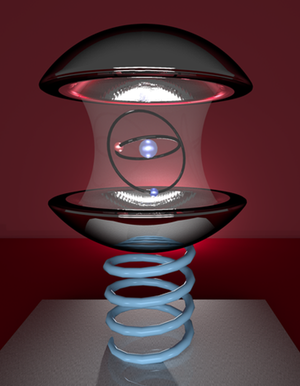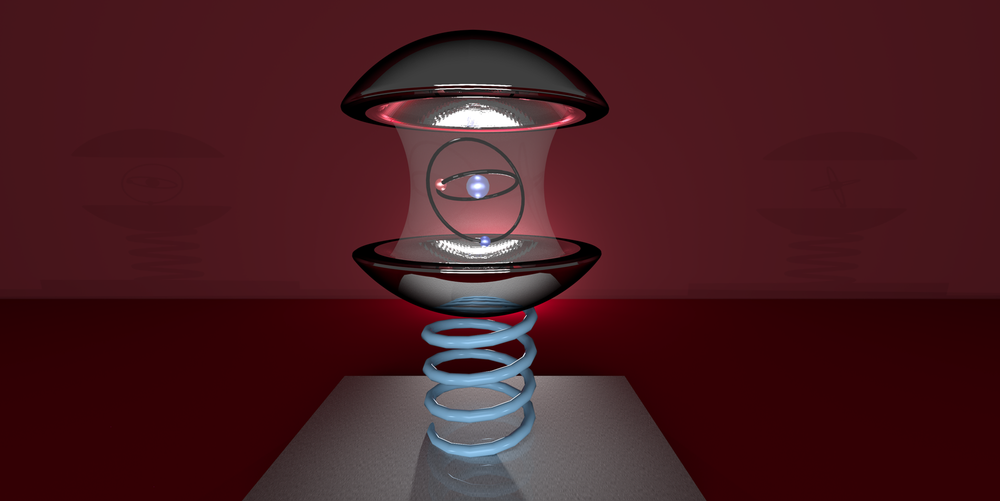Device Couples Light to Atom and Quantum Motion
Pushing the boundaries of quantum experiments, theorists have proposed devices that combine mechanical vibration, single photons, and a single atom. Now a team reports in Physical Review Letters that they have completely solved the quantum mechanical equations for such a system and have shown that it could lead to a wide range of quantum explorations. For example, the mechanical motion could be reduced to the level of a single phonon, the quantum unit of vibrations, and it would be capable of emitting single phonons into its support structure. One of the authors is already working on building the device, which the team believes could lead to studies of the behavior of quantum phenomena at macroscopic scales.
To study the interplay between a photon and an atom, researchers can trap the two particles inside a small cavity and nudge the atom to absorb or emit a single photon. This field of cavity quantum electrodynamics (cQED) has been developing over the last 15 years, says Cristiano Ciuti of Paris Diderot University. Recently, another field called optomechanics has also begun to flourish, looking at how light interacts not with atoms but with larger objects, such as a small mirror that oscillates when struck by photons.
A fundamental question is whether and how quantum behavior extends to large objects like mirrors. To address such questions, several researchers have proposed hybrid devices that combine cQED with optomechanics. Now Ciuti, Paris Diderot colleague Ivan Favero, and graduate student Juan Restrepo describe one at the level of single quantum states and without approximations from classical physics.
The theorists analyze an electromagnetic field (photons) simultaneously coupled to an atom and to a vibrating object, without referring to any specific experimental setup. But one setup with a good chance of working in the lab involves a so-called artificial atom: An electron confined to a nanometer-scale piece of semiconductor called a quantum dot can have two energy levels or quantum states, similar to a real atom. It can emit or absorb a photon when making transitions between the two states.
The optomechanical part could be a pillar or a disk of semiconductor material, several micrometers wide, which vibrates at specific frequencies and can trap within it a photon that is coupled to the vibration. This so-called optomechanical resonator would have a quantum dot inside.
The theorists found that the system can dramatically reduce (cool) the vibrational motion to such a small amplitude that it needs to be described by quantum rather than classical mechanics. For the dot-inside-pillar experiment, the cooling would start with a specific frequency of laser light. A laser photon could be absorbed and then re-emitted multiple times by the dot as the photon remains trapped within the pillar. During that time, the photon could absorb the energy of one or more phonons—quanta of vibration—from the vibrating pillar and thus reduce the structure’s vibrational amplitude. The photon would eventually escape the cavity. The researchers’ calculations show that in a cold environment and after many photon cycles, the vibration could be rapidly reduced, so that it approaches the lowest level allowed by quantum mechanics, corresponding to the energy of a single phonon.
The team’s analysis also shows that hitting the device with another frequency of laser light could cause it to emit single phonons at regular intervals into its support structure. Favero can even imagine “phonon guiding structures” that would direct these vibrational quanta away for further study. He says that studying individual phonons is important because processes such as heat flow are mainly understood in terms of the collective behavior of phonons. But “the transition between individual phonons and the macroscopic collective behavior is unexplored,” says Favero. He is currently working with colleagues to build the device in his lab.
Ciuti hopes to explore other fundamental questions. “Does the standard quantum physics description apply to these systems [that] have a macroscopic mass?” he asks. He says the system could also lead to extremely precise accelerometers and force sensors.
“The remarkable rate at which experiments are advancing suggests that such tripartite systems may become routinely accessible in the near future,” says Steve Girvin of Yale University. “A new window into complex quantum dynamics may be about to be opened.”
–Marcus Woo
Marcus Woo is a freelance science writer in the San Francisco Bay Area.





